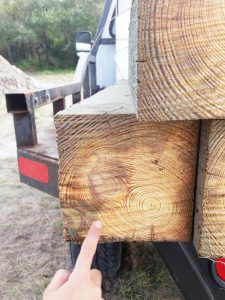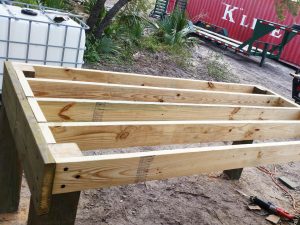
Platform of Strength
Last week, the free water collection was worked out leaving the Planner with the next, more difficult step. The water management system. As mentioned before, the system for moving water from one tote to another is not as simple as turning on a valve. Fortunately, there is still time to work out all the details for the management system. Right now, there is a platform to build. And oh, what a platform it is, too.
As with all structures built, there was long term planning to consider before building. One of the possibilities to consider was where Boxes in Fields planned to use their daily water usage from. Would the water just pull straight from the 3000 gallon storage tank, the 50 gallon holding tank in the RV, or a 330 gallon IBC tote? What happens if and when family members decide to have a weekend retreat? Will they have their own IBC tanks?
I can hear your wheels a spinning from here. You are asking yourself, “why not run straight from the 3000 gallon tank itself? Wouldn’t that make everything so much easier.” And the answer is yes, it would be so, sooooo much easier. However, let me ask you this one question? “How many times have you left the water running because you were watering the grass, washing the car, cleaning the windows and you went inside and got sidetracked?” Uh huh, that is what I thought. While we are going to be able to collect 25 gallons of water a day there is still not enough water for water wasting on simple mistakes such as leaving the water running, even at a trickle. Therefore it was determined for our needs it would be best to run our daily water usage from an IBC tote. When an accident happens and the water will be left on, only 330 gallons would be wasted, not 3000 gallons.
Running daily water allotment from the IBC tote also makes it a little easier in the planning of the water management system. The tote will need to be stored off the ground to attach to the pressure tank and pump. The entire management system must be enclosed to protect from harmful, algae-inducing UV rays and salt corrosion. This platform, like all permanent structures at Boxes in Fields, has to be set above grade level at a base height of around four feet. It is this need to be above ground that has resulted in this platform of superior strength.
A 330 gallon IBC tote weighs 150 lbs empty, 2640 lbs full, and measures 40″L x 48″W. Just storing the tote alone requires half a sheet of plywood leaving very little space for the pump, pressure tank, and water management system. In order to secure correct footing stability, the 6″x6″ piers, which were salvaged from One Man’s Trash, had to be placed 32″ deep. Fortunately, digging was easy work as there are no rocks and very little roots to have to manage around. Tamping, on the other hand, is all laborious work. Especially when the piers are secured to form boards ensuring squareness with the world. Having a pier leaning left or right would not be very strong or pretty and would defeat the purpose of all the setup work.
And if you are going to do all the correct setup why would one cop out and not tamp the piers tightly. It is not like one can simply push the pier, once set, to position it correctly. Do it right the first time, right? But doesn’t it seem like doing it right, always takes more time? If you were more of a glass is half full kinda of person, like myself, then you would find the enjoyment and zen qualities in tamping.
Come on tell me the truth, wasn’t that just relaxing? It was just as relaxing to tamp too, I promise. If you were more like me that is…. Also, I would like to give a shout out to the Kid who filmed this video. He did a pretty good job didn’t he?
With all four piers securely in place, a transit was used to mark off the correct height on each pier. Trying to guarantee the piers are the same height using any other method is madness. Once marked, a Sawzall makes easy work of removing any additional height. Now, not only are the piers right with the world, the deck will be flat with the world.
The Sawzall also makes for quick work of removing the area needed to place the 2″x6″ floor joists. Some people find the accuracy of a Sawzall not reliable, some people find usage spooky and reckless due to the lack of blade sheath, some people find them as a tool for the unskilled. Oh well, it is a good thing we are not those some people. Every tool serves a purpose. Are there better tools for suited to trimming piers? Sure. But this tool is already owned and it will get the job done just fine. It is not like the platform will lose credibility because a Sawzall was used. Good grief, don’t be a tool snob.
The decision to use all pressure treated materials was debated and debated. Let’s think about this rationally. The platform is holding a water management system, therefore, there will be water spillage, constant dampness, and condensation drippage. Being in South Texas, the spring/summer/ fall heat will dry out the boards during the day from any moisture obtained during the night. Pressure treated materials were used as additional preventative maintenance.
Flooring installed, all that was left was to lay down a piece of 3/4″ pressure treated plywood. The Kid marked every six inches to secure the plywood to the joist. As it was, just in the week the plywood has laid out in the elements it has already obtained a small warp. And yes, poly-coated screws were used as preventative maintenance too. Hello, has it not already been mentioned Boxes in Fields lives in the salt corrosion capital of the world. If not, let’s reiterate: Welcome to our town, where plastic rusts.
All in all, the project went very smoothly and surprisingly only took fours days to complete. If a flood comes, I call dibs on this platform. If the flood is less than four feet. Let’s hope the more complex by the minute, water management system goes just as smoothly.











